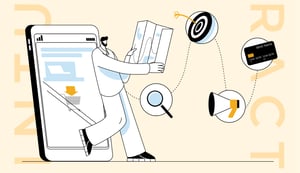If you're a SaaS marketer or business owner, you probably know the feeling of building a product that you're proud of but struggling to get people to actually use it. One of the biggest reasons for this is often a lack of focus on user onboarding. You may have read guides, attended webinars, and tried to figure it out on your own but still feel like there's a missing piece to the puzzle.
In this blog, we will solve that problem and bring you a user onboarding process that not only gets your users up and running with your product, but also sets them up for long-term success.
Creating a Successful Onboarding Experience For Users In 4 Steps
In order to get your product started with a good user onboarding process we recommend starting with these action items in three phases —
- Strategize
- Know the success gaps, milestones & desired outcome
- Review actionable metrics, select upgrade triggers & events to track
- Map out emails, in-app messages and walkthroughs
- Implement
- Implement walkthroughs & / or in-app messages
- Setup drip email campaign
- Setup Tracking
- Optimize
- Review Progress
- Repeat
Let's walk through these steps in detail.
Know the desired outcome & success gaps
The desired outcome for a customer is the end goal or objective that they hope to achieve by using a product or service. It is the benefit or value that the customer is looking to gain from the product. For example, a customer may use a project management software with the desired outcome of increasing productivity.
The success gap refers to the discrepancy between a customer completing the necessary tasks within a SaaS product according to the vendor's definition of success and the customer achieving their desired outcome. For example, a customer using a project management software may successfully create a project plan, assign tasks, and set deadlines, but if the objective of the project was to increase productivity and that objective was not met, the customer has not achieved their desired outcome despite completing all the steps in the software.
Here's a worksheet you can use to note your findings on desired outcomes and success gaps.
Review actionable metrics, select upgrade triggers & events to track
Identify the steps your customers will take within your funnel and the most important metrics behind them.
Here's an example of actionable metrics for a SaaS product, Hotjar that helps marketers see their website from the eyes of the customers. You can copy this worksheet to note down your metrics.
One important aspect of this step is to select upgrade triggers and events to track. Upgrade triggers are actions that indicate a user is ready to move to the next level of engagement with your product. For example, a user who has completed a certain number of tasks or reached a certain level of proficiency may be a good candidate for an upgrade. Tracking these triggers can help you identify users who are ready to move on to the next level of engagement with your product, and target them with appropriate messaging or incentives.
Map out emails, in-app messages and walkthroughs
The next step in user onboarding is to map out the communication channels that will be used to guide users through the onboarding process. This includes emails, in-app messages, and walkthroughs. By mapping out these communications in advance, you can ensure that users receive the information they need at the right time, in the right format, and through the right channel.
For example, an email can be sent to the user after they have created an account and verified their email address. This email can provide an overview of the product, key features, and a call to action to schedule a demo or training session.
After the user has completed the demo or training session, in-app messages can be used to guide them through the different functionalities of the tool, highlighting key features and providing tips for getting the most out of the tool.
And walkthroughs can be used to provide users with a step-by-step guide on how to complete specific tasks within the tool.
And by aligning the communication with the user journey, you can increase the chances of user engagement and successful product adoption.
Implement and Optimize
Implementing a user onboarding strategy can be a complex process, but by using a general onboarding tool stack, it can be made simpler. While some tools may be substituted for others, the overall process remains the same. Let's take a look at how it works in practice.
Segment: A tool used for pushing and pulling data, it acts as the backbone of your data by sending and receiving information from each tool and your product.
Appcues or Inline Manual: These tools are used for creating walkthroughs, but it is important to be selective in their use and keep them concise, focusing only on the highest value areas.
Google Tag Manager (GTM): This is used for event tracking and acts as your Data Layer, pushing site data and event tracking to Segment. Note: It is important to install GTM directly on your site and product to avoid duplicate data issues.
Intercom: Tool for sending triggered emails and in-app messages during the user onboarding process.
Amplitude: This is used for visualizing outcomes and creating funnels, charts and graphs by taking the data pushed to Segment. It offers 10 million free events, making it a great choice for SaaS products.
As you implement your user onboarding strategy, remember that it is normal to have to tweak and add areas to refine the tracking and implementation. Focus on closing success gaps and helping users achieve their desired outcome.
Examples of User Onboarding of SaaS Product
Airtable’s onboarding flow starts with a video to reiterate value and make you excited for that first-run product experience. It tries to understand the user’s persona and any relevant use cases to tailor the user onboarding experience.
Wistia's user onboarding program begins by identifying users' primary goals and level of expertise. Using this information, the platform guides users through the video-making process by providing a checklist of actions for them to complete. This could include uploading their own videos or using pre-made ones on the platform.
By requiring active participation in the process, Wistia ensures that both new and experienced users are fully engaged and motivated throughout the onboarding sequence.
Do You Need Help Creating a Highly Effective User Onboarding Process?
Now that you understand the importance of user onboarding, it's time to think about how you can implement it in your own SaaS business. While it's possible to do it on your own, you may want to consider working with a specialized agency like Inturact.
Inturact is a SaaS onboarding agency that can help you create a user onboarding process that is tailored to your specific product and audience. We have a team of experts who can guide you through the process and help you create a user onboarding process that will help you increase user retention, and ultimately drive more revenue for your business. So, if you're ready to take your user onboarding to the next level, consider working with Inturact today.



